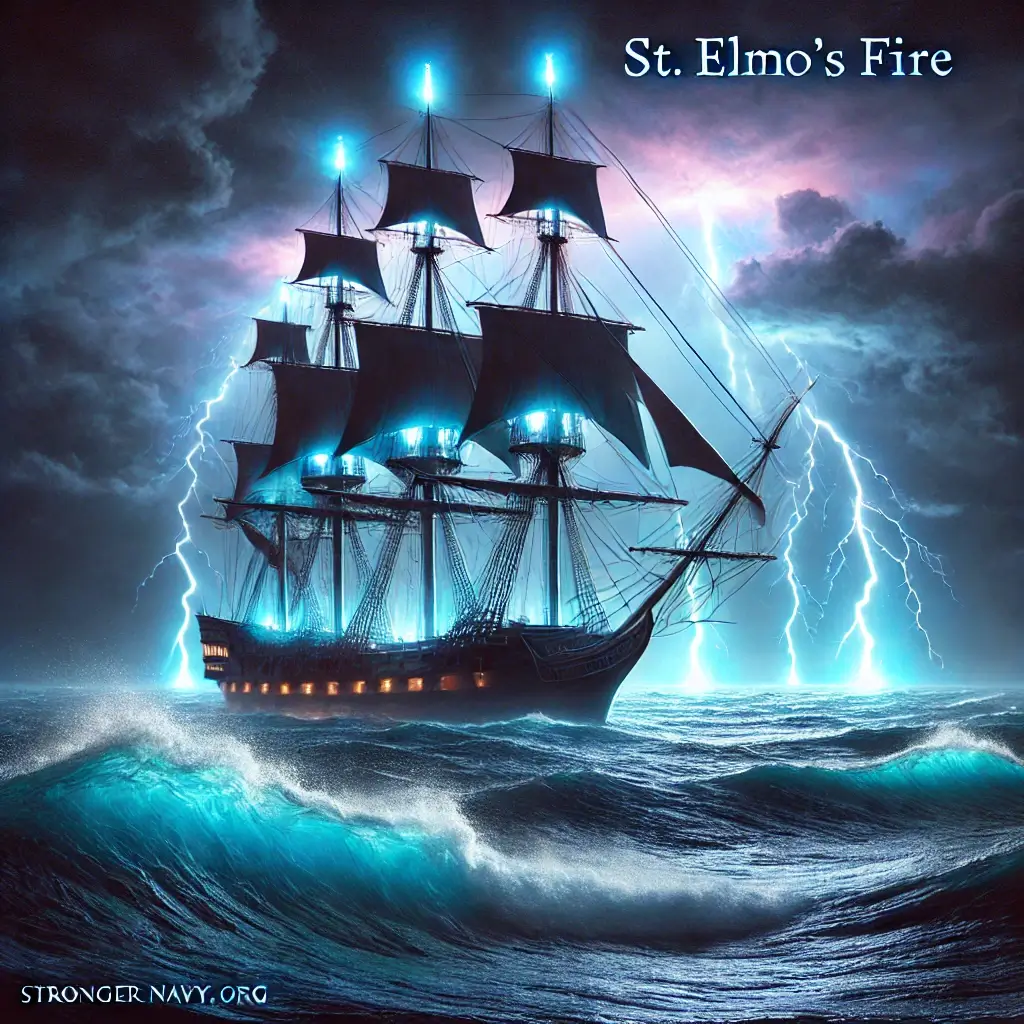
Taking a Moment to Reflect on Naval Lore
Introduction
In the fast-paced world of naval news and advocacy, it’s easy to get caught up in the pressing issues of the day—whether it’s the latest developments with the Houthis, the growing tensions in the South China Sea, or the ever-present need for more ships and submarines to keep our Navy strong. But sometimes, it’s worth taking a step back to appreciate the stories and traditions that have shaped the Navy over the centuries.
These tales, though less urgent, offer us a chance to connect with the rich history of the sea and those who have served on it. Today, I want to share one such story—a fascinating phenomenon known as St. Elmo’s Fire. It’s a piece of naval lore that reminds us of the mysteries of the ocean and the timeless bond shared by sailors throughout history. Taking a break from the headlines, let’s dive into something a bit different, yet deeply tied to the spirit and resilience that defines our Navy
In the vast and unpredictable world of the open sea, sailors have witnessed countless awe-inspiring phenomena. One such occurrence, often shrouded in mystery and legend, is St. Elmo’s Fire. While its name might evoke thoughts of an 80s movie for some, its true significance lies in its rich maritime history. Today, we’ll delve into the science and lore of St. Elmo’s Fire, its importance to sailors, why it matters for America, and how it ties into the mission of StrongerNavy.org.
What is St. Elmo’s Fire?
St. Elmo’s Fire is a weather phenomenon involving a visible glow, often bluish or violet, that appears near the tips of pointed objects such as ship masts, aircraft wings, or even church steeples. This eerie light is caused by a discharge of atmospheric electricity in conditions of strong electric fields, typically during thunderstorms.
The intensity of the effect, characterized by a blue or violet glow around the object, often accompanied by a hissing or buzzing sound, is directly related to the strength of the electric field. As a result, it’s most noticeable during thunderstorms or volcanic eruptions.
The Navy’s Relationship with St. Elmo’s Fire
For centuries, sailors have regarded St. Elmo’s Fire with a mix of awe and superstition. Named after St. Erasmus of Formia, the patron saint of sailors, this phenomenon was seen as a good omen, a sign of protection from the saint himself. To seafarers navigating the treacherous waters, the glow provided a sense of hope and divine safeguarding during storms.
Why It Matters
Understanding St. Elmo’s Fire goes beyond appreciating a natural light show. Here’s why it’s significant:
- Historical Context: Knowing the history of maritime superstitions and phenomena like St. Elmo’s Fire deepens our respect for the sailors who braved the seas in times when scientific understanding was limited.
- Educational Value: It provides a perfect example of how atmospheric conditions can create electrical discharges, linking it to broader weather patterns and safety precautions in modern navigation.
- Cultural Heritage: Recognizing and preserving these maritime traditions strengthens the bond between today’s Navy personnel and their historical counterparts, fostering a sense of continuity and pride.
Why Should America Care?
At StrongerNavy.org, our mission is to engage Americans in supporting and understanding naval affairs. Here’s why this story matters to our broader goals:
- National Security: The stories and phenomena experienced by our sailors, like St. Elmo’s Fire, highlight the unpredictable nature of their work and the need for a well-prepared, well-supported Navy to protect our nation’s interests.
- Inspiring Future Generations: Sharing these tales of maritime lore can inspire young Americans to consider careers in the Navy, ensuring that we continue to have the best and brightest protecting our seas.
- Strengthening Civic Engagement: By educating the public about naval history and phenomena, we foster a deeper appreciation and support for our armed forces, encouraging more active civic participation and advocacy for a stronger Navy.
Who Should Care?
- Sailors and Navy Personnel: For those currently serving, understanding the history and science behind such phenomena enriches their naval heritage and enhances their navigational knowledge.
- Historians and Enthusiasts: Maritime historians and enthusiasts will find the blend of folklore and science intriguing, offering insights into past naval practices and beliefs.
- General Public: Educating the broader public about these natural occurrences fosters a greater appreciation for the challenges and wonders faced by sailors throughout history.
Turning a Negative into a Positive
When a reader made a snide remark, calling me a “snipe” after I confused St. Elmo’s Fire with a movie, it was a humbling reminder of the gaps in my knowledge. However, rather than taking offense, I saw it as an opportunity to learn and educate. Here’s how to transform such moments into positives:
- Embrace Curiosity: Use misunderstandings as a springboard for research and learning. Curiosity is the first step to expanding one’s knowledge.
- Educate Others: Turn your newfound knowledge into educational content. By sharing what you’ve learned, you can help others avoid similar misconceptions.
- Foster Respect: Acknowledge the expertise of others and show respect for their knowledge. This approach not only builds camaraderie but also strengthens community bonds.
Conclusion
St. Elmo’s Fire is more than just an atmospheric phenomenon; it’s a symbol of hope, protection, and the enduring spirit of sailors navigating the unknown. By understanding and appreciating its significance, we honor the legacy of those who came before us and enhance our connection to the maritime world. At StrongerNavy.org, we believe that these stories are crucial in building a stronger, more informed, and engaged America. Let’s continue to explore, learn, and share, turning every encounter into an opportunity for growth and understanding.

